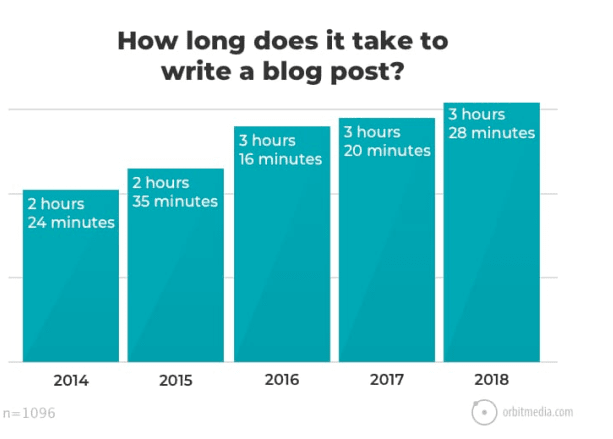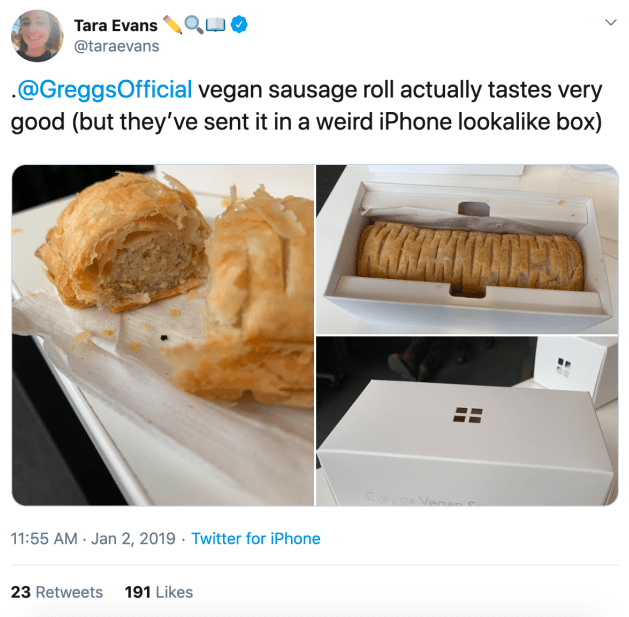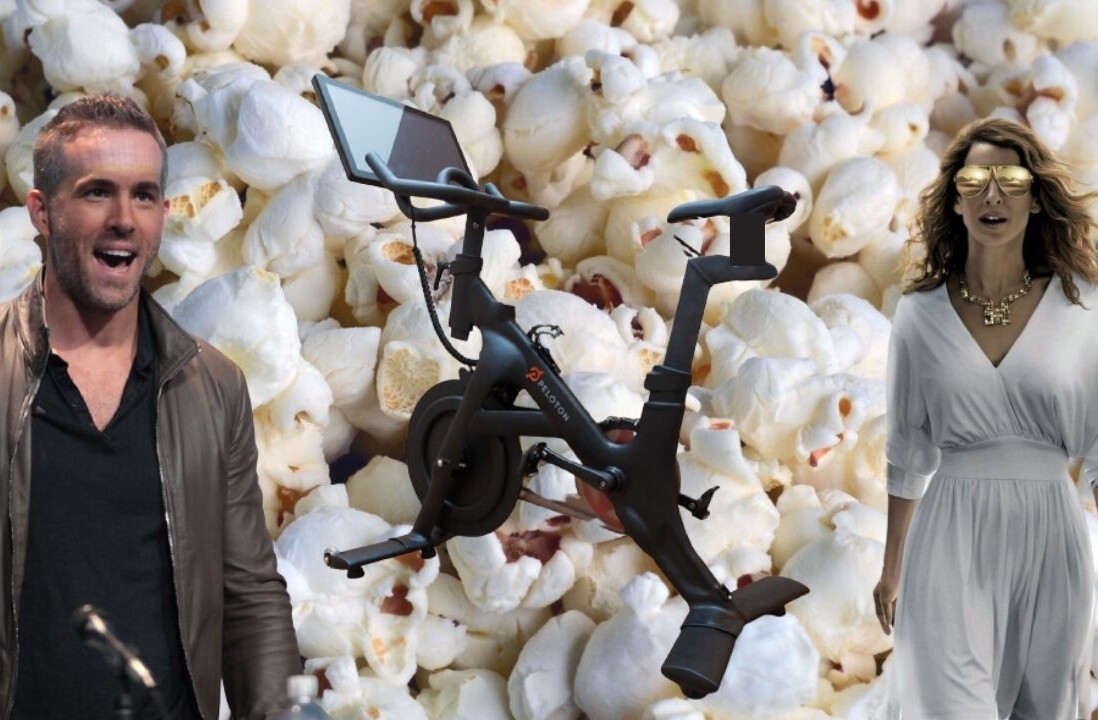
Did you know we have an online event about digital marketing coming up? Join the Re:Brand track at TNW2020 to explore the latest brand marketing tech, trends, and challenges. Alex Antolino, the Creative Director at Typeform, will be sharing powerful branding insights and actionable strategies on how to build meaningful brands that lead to business growth.
So you Googled ‘content marketing examples,’ you thought, “this one looks a bit different,” and now you’re here.
Welcome!
A bit of advice before you proceed:
If you’re new to all this, school yourself on the basic types of content marketing with this quick-fire crash course of old favorites. But if you’re ready for some fresh content creation ideas, skip to the 7 content marketing examples you’ve never heard of below.
Here’s 8 tried and tested content marketing examples:
Blog posts
You might have read an article called something like: “Blogging is dead: why your audience hates reading—and why you should too.” But if that was true, you wouldn’t be reading this post right now. And you wouldn’t have read that article either.
What your audience actually doesn’t want to read: mediocre posts with bland info. The more effort you put in, the better the results.

Infographics
People can’t get enough of infographics. They’re handy cheat-sheets of stats that make you seem like you know what you’re talking about.
And if you fill them with stats like “sites that publish infographics get 12% more traffic,” people will link to them—see that?
Case studies
To understand what a product’s really about—nothing beats a normal person telling you their real experience with it.
Here’s one we made about someone using Typeform. The short “Challenge, Solution, Result” summary at the top lets people quickly see if it’s relevant to them.
Video
‘Video content’ always makes lists of content marketing examples. But ‘video’ is not a content marketing example—no more than ‘writing’ is.
The question is: what kind of videos you should be making? We’ll look at some innovative ways to unlock the potential of video in the next section.
Ebooks
Ebooks are long, downloadable reads that go deep on a topic. In exchange for this trove of research and info, companies ask for an email address to add to their pile of leads.
Since people are parting with their email, your ebook needs to be worth a lifetime of your marketing in their inbox. Independent research, data, an expert insights are the way to go.
Webinars
“Does anyone actually watch webinars anymore?” A quick Google search of this question gets an answer of mainly ‘yes.’ But most of the results are from webinar software companies. So who really knows?
Here’s some advice: unless you can get a famous expert—or even better, a panel of them—to appear in your webinar, don’t bother. It’s a lot of hassle, and there’s a high risk of embarrassment if no one tunes in. We know. It happened to us.
Podcasts
It’s not just LA hipsters stuck in traffic who like them anymore—44% of Americans have now listened to a podcast. Some marketers think they’re the holy grail of content marketing.
And if you already have a big audience, the audio equipment, and hosting talent—then go for it. But if you’re an early-stage marketer, maybe hold off. Podcasts take time and skill to pull off, and building an audience for them is not easy.
That’s the classic types of content marketing taken care of. Now here’s the list we’ve all been waiting for. Sure, they won’t all be right for your business. But hopefully these ideas will inject some fresh thinking into your content marketing strategy.
Here’s 7 content marketing examples you’ve never thought of:
Documentaries
2018 was the year of the documentary. After spending decades being dismissed as something you fall asleep to in geography class, docs are now killing it both in theatres and on streaming services. Vertigo-inducing climbing doc Free Solo racked up $17million at the box office, and Netflix bought democrat-umentary Knock Down the House for $10million.
Why are docs so popular right now? Veteran documentary producer Michael Kantor has an idea:
People are really searching for the truth right now. They want to hear something that’s not packaged for consumption and not hyped a certain way. – Michael Kantor, Documentary Producer.
This is a vital message for content marketers who want to explore the potential of video. People don’t want flashy, salesy, corporate videos—they want down-to-earth authenticity.
Documentary-style videos are relatively cheap too. Why spend 40 grand on a slick brand video when you could spend ten times less on a thought-provoking piece of content that people actually want to watch?
Some companies have already figured this out. InVision makes software for designers, so they made Design Disruptors—a feature-length documentary full of influential designers waxing lyrical about their passion. They even went all out and organized screenings instead of putting it on YouTube.
The result? Thousands of designers came to watch it—their exact target audience. The trailer alone has 294k views. That kind of brand awareness is invaluable.
We’ve dabbled in documentary ourselves. Our target audience is marketers who care about design, so we made a doc about our rebrand. It wasn’t as big as InVision’s, but it got 20k views and a few hundred leads:
Still not convinced? Check out Velocity Partners’ article on why B2B documentaries are the next big thing.
Quizzes
Okay, so maybe you already thought of using a quiz for content marketing. But it doesn’t show up on most of these listicles, so I’m putting it in the ‘fresh’ pile. And people will never stop loving quizzes.
Here’s how it works:
- Make a quiz
- Share it on social—
or LinkedIn works best—or embed it in your website - Ask for their email address before you reveal their score
Simple, yet effective. There’s just a few details you need to work out if you want to try this at home.
First up is quiz type. A score quiz tests people on a topic and reveals how many correct answers they got at the end. Who doesn’t want to feel like a smart-ass?
Make sure your score quiz is about a topic that tests your target audience. For example, if your product is an SEO tool, you’d reel in the SERP nerds with something like this:
Or you could go with a personality quiz. People can’t resist answering a series of questions that reveal the type of person they are. Who doesn’t love being categorized by Buzzfeed?
Beardbrand got 80k leads from embedding their ‘What type of beardsman are you?’ quiz on their homepage:
Remember: people reach peak engagement at the end of a quiz, so you get them to do pretty much anything. Redirect them to your homepage, ask them to share it, trick them into giving you their bank details. Not that last one, obviously.
For more on content marketing with quizzes, check out our social media quiz article.
Chatbots
Remember when everyone was going mad for chatbots in 2016? Turns out, the hype was a bit over the top—at least when it comes to lead generation. But when they’re done right, chatbots can be an effective example of content marketing.
Imagine you’re reading a long magazine article. The columns of the main article are usually sandwiched between two things—glossy photos, and boxes with more text. These boxes normally go into more detail about a specific point from the main article. A welcome detour for curious people.
Why not sprinkle content for the curious on your articles with some chatbots? A chatbot can deliver info in a fun, conversational way, and it lets the reader choose which topic they want to hear more about. You can even ask people what they think of the content, or to sign up to your newsletter.
We first tried this with an article about chatbots—meta, we know—and it was a big hit for us. People loved that they could talk to the author of the article while they read it. They thanked us with several thousand backlinks.
Want to make something like this yourself? Keep one thing in mind: your chatbot needs to look slick embedded into your article. Embedding a conversation with Typeform is one way to do this. Have a chat with the strange characters on this page to see how it looks.
Interactive video
Speaking of interactive content marketing examples, ever experienced an interactive video? Netflix jumped on this trend with Black Mirror: Bandersnatch in 2018. And it was a huge, Emmy-winning hit.
If you missed it, you select choices affecting how the story unfolds as you watch the film. You see different scenes depending on your decisions, taking you towards one of the multiple endings.
OK, so making one sounds a bit complicated. But here’s two reasons you should make an interactive video.
- They’re the definition of engaging—your audience will love it
- Making one isn’t actually that complicated
And here’s the proof (at least the trailer):
Our content team used a hackathon to hack together their own interactive video. They wrote it, filmed it, starred in it, and convinced a developer to help them code the choices. And it only took a day and a half.
The result? Around 30k views, and 4,000 people signing up to our content newsletter. And some kind words:
I loved how innovative and interactive it was. I shared it with at least five of my close friends. We all agreed that it took us back to reading those choose-your-own-adventure Goosebumps books when we were children. – Molly Vernarecci, Founder of MJV Consulting
Making an interactive video might seem a little out there—but that’s the whole point. Get it right and people won’t forget it. These days, there’s even a bunch of tools to help you make one. So why not start your own content hackathon and give it a go?
Calculators
When I took my first freelance copywriting job, I had no idea what to charge—as you might have noticed, I’m more of a blog-writing kind of guy. Getting paid per article or per word is pretty straightforward. But copy’s a weird one—lots of research and thinking, only a few important words as a result. I wished there was an expert who could give me a ballpark figure.
Luckily, I knew a guy. But since then, I discovered this freelance copywriter quote calculator by Copyhackers. You answer a few questions, then it automatically calculates a quote for you. It’s quite basic, but it gives you a more personalized, concrete answer than a blog post could.
One man who’s nailed calculators as a type of content marketing is public speaking coach Grant Baldwin. Everyone kept asking him the same question: how much should I charge for a speaking gig? So he built this calculator and put it on his website:
Since then, it has calculated a fee for over 50k people. He used it to build a massive audience for his coaching services by asking for people’s email in return for their quote.
So if people keep asking you for estimates, it’s time to build a lead-generating calculator of your own. For more inspiration, here’s another calculator success story involving kitchen robots.
Direct mail
Or to use the 20th-century term, ‘mail.’ Actual, physical mail. Remember that? Nah, me neither. I heard it was huge.
But seriously, in our omni-digital world, people have started to crave the authenticity of physical objects. Vinyl records are cooler than ever. Millennials have ditched Kindles for paper books. And some savvy marketers have realised that content marketing ≠ digital marketing.
Disclaimer. That doesn’t mean you should start doing this:
Why not?
- Receiving a ton of marketing bullshit in your mailbox is annoying
- You’ll get climate canceled for wasting paper
- It’s not targeted at a specific audience
Instead, smart marketers are sending out limited edition packages to specific influencers and loyal customers. Beautiful, fun objects that people might keep on their bedside table—or even better, share on Instagram with their influencer-sized following.
So what should you send people? Anything—as long as it puts a smile on their faces and makes them reach for their phone camera. Here’s a perfect example.
British bakery chain Greggs launched its vegan sausage roll in January 2019—‘Veganuary.’ But that was just the start of Greggs’ genius content marketing.
They hand-delivered it to vegan influencers and journalists packaged like this:

Look familiar? The iPhone box got big laughs and even bigger shares. The vegan sausage roll went viral thanks to reviews like this one by Vice, which described the mock-Apple package as “tongue-in-cheek excellence and the height of self-awareness.” Greggs’ overall sales jumped 10% as a result of the new roll’s popularity.
So if you want to try out direct mail in your content marketing campaigns, it’s worth spending some time and money on making something memorable. And cherry-pick who receives it to keep costs down—the rarer the item, the cooler and more shareable it becomes.
Comedy
How many times has a brand made you laugh? Probably not that many. So the times a brand does make you laugh tend to stay with you.
When it comes to brand interactions, it doesn’t get much more positive than making someone crack up.
But a word of warning: not many companies can pull this off. This might be the most challenging content marketing example on the list. Mess it up and you risk embarrassment.
To avoid this, here’s a quick list of don’ts:
- Don’t do anything that could offend anyone
- Don’t rely on cheap, worn-out clichés
- Don’t publish the content without testing it on a lot of co-workers
That last one is the most important, as it’ll help you realize if you’re doing the first two.
One company investing in laughs is Mailchimp.
They launched the professionally produced mockumentary series Trade Shows to poke fun at a topic their audience can relate to—the bizarre world of conferences. It’s hosted on Mailchimp Presents, their “business entertainment platform” focusing on the challenges of entrepreneurship and owning a small business.
Why spend time and money on high-quality content with no direct connection to your product? Mailchimp’s Senior Content Strategy Manager, Erin Crews, explains:
Many companies are really good at giving actionable advice. But people also want emotional reassurance that they’re not alone. – Erin Crews, Content Design & Strategy Manager at Mailchimp
This is the key to making comedic content marketing—and in fact, any great content marketing.
Make it relatable.
Beyond giving people the info they need, show that you understand their frustrations. Present boring, complex topics in a way that’s fun and digestible. Empathize with the uncertainty they feel when Googling a phrase like “content marketing examples,” and think: what would I like to find on page one of Google*?
So remember, whether you’re writing a blogpost or embedding a chatbot into an interactive zine: start from empathy in your content marketing, and you’ll do just fine.
Get the TNW newsletter
Get the most important tech news in your inbox each week.




